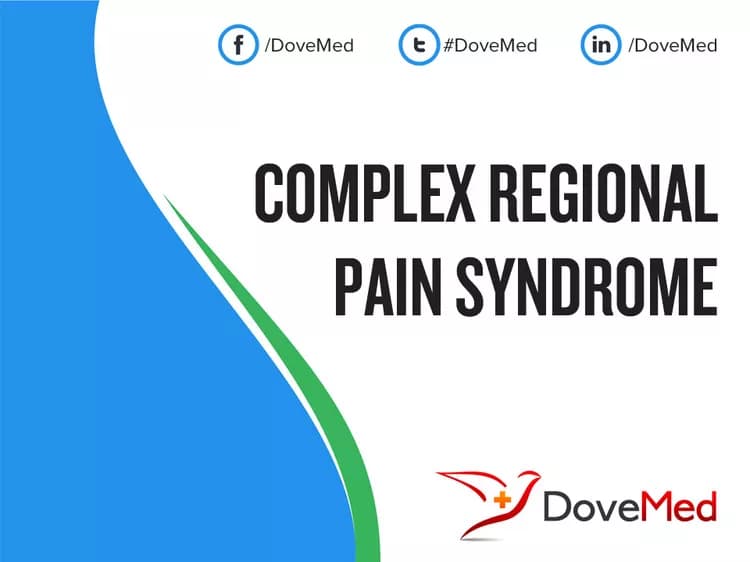What are the other Names for this Condition? (Also known as/Synonyms)
- Causalgia - RSD
- Reflex Sympathetic Dystrophy Syndrome (RSDS)
- Sympathetically Maintained Pain
What is Complex Regional Pain Syndrome? (Definition/Background Information)
- Complex Regional Pain Syndrome (CRPS) is a chronic and progressive condition that often affects the arms, hands, legs, or feet. It usually develops after an injury, surgery, stroke, or a heart attack
- The condition is characterized by pain that is usually disproportional to the severity of the injury. Complex Regional Pain Syndrome is 3-times more likely to occur in women than men
- The exact cause of development of Complex Regional Pain Syndrome is unknown. However, researchers believe that an abnormal functioning of the affected nerves, or dysfunction of pain perception in the brain may be possible causes
- Complex Regional Pain Syndrome is an uncommon disorder, in which an individual may have intense pain, alteration of skin color, swelling, and temperature change of the affected region. In many cases, the pain may be felt in regions away from the site of injury. For example, an individual with injury to the right leg may experience pain in the left leg
- Treatment of Complex Regional Pain Syndrome is more successful if it is started early, especially if the signs and symptoms are mild. In individuals, who have severe signs and symptoms, the recovery is often slower. In others, the signs and symptoms can worsen over time, leading to long-term disability
There are two types of Complex Regional Pain Syndrome:
- Type 1 occurs following an injury or illness, which did not directly injure any nerves surrounding the affected extremity. A high percentage of individuals, who develop Complex Regional Pain Syndrome, have Type 1 Complex Regional Pain Syndrome
- Type 2 Complex Regional Pain Syndrome occurs after a confirmed distinct nerve injury
The signs and symptoms of both Type 1 CRPS and Type 2 CRPS are similar.
Who gets Complex Regional Pain Syndrome? (Age and Sex Distribution)
- Complex Regional Pain Syndrome (CRPS) may occur in individuals of all ages, races, ethnic groups, and both genders. However, it is extremely rare in children below the age of 10 years
- Overall, this condition is more common in individuals between the ages of 25 and 55 years. The condition is also not uncommon in teenagers
- Women are 3-times more likely to develop CRPS than men
- Its uncommon to find CRPS in elderly individuals
What are the Risk Factors for Complex Regional Pain Syndrome? (Predisposing Factors)
The risk factors associated with Complex Regional Pain Syndrome are not entirely understood. However, several contributing factors are present which may include:
- Minor or severe injury to the affected area
- A previous surgical procedure performed on the area
- Injury to a nerve associated with diabetes (diabetic neuropathy)
- Peripheral nerve injury
- Heart attack
- Stroke
It is important to note that having a risk factor does not mean that one will get the condition. A risk factor increases ones chances of getting a condition compared to an individual without the risk factors. Some risk factors are more important than others.
Also, not having a risk factor does not mean that an individual will not get the condition. It is always important to discuss the effect of risk factors with your healthcare provider.
What are the Causes of Complex Regional Pain Syndrome? (Etiology)
There are two types of Complex Regional Pain Syndrome (CRPS) that can occur, with related signs and symptoms. The causes include:
- Type 1 Complex Regional Pain Syndrome: Type 1 CRPS occurs following an injury, or an illness, which did not lead to a direct injury to nerves on the affected extremity. A high percentage of individuals, who develop Complex Regional Pain Syndrome, have Type 1 CRPS (which was previously called Reflex Sympathetic Dystrophy Syndrome)
- Type 2 Complex Regional Pain Syndrome: Type 2 CRPS develops after a confirmed nerve injury. This CRPS type was previously called Causalgia
What are the Signs and Symptoms of Complex Regional Pain Syndrome?
The signs and symptoms of Complex Regional Pain Syndrome (CRPS) vary in severity and duration from individual to individual. The common signs and symptoms include the following:
- Pain in the affected limb: In some individuals, the pain is felt as a burning sensation, whereas in other individuals, it may be perceived as ‘pins and needles’ sensation. Sometimes, the pain can be felt in the entire arm or leg, away from the site of injury. The perceived pain is often disproportionate to the stimulus; e.g. a light touch to the affected area can cause severe pain. This symptom is called allodynia
- The affected region can show changes in skin color, temperature changes, and swelling. These changes can either be present continuously, or fluctuate back and forth, with time. The aforementioned changes are thought to occur, due to damage to the nerves that are responsible for temperature regulation and blood circulation
- Abnormal joint stiffness, muscle movement, and abnormal posture of the limb, called dystonia
- Abnormal tremors and jerky movements, observed on the affected limb
In a majority of cases, there are 3 stages to Complex Regional Pain Syndrome. However, some individuals may develop severe CRPS immediately:
Stage I: Acute stage (may last between 1-3 months)
- Noticeable skin temperature change sensation - between warm and cold
- Changes in skin color that range from very pale to pink (discoloration of skin)
- Hair and nails grow at abnormal speeds
- Muscle spasms and joint pain
- Worsening pain and burning sensation, when the affected region is touched
Stage II: Dystrophic stage (may last between 3-6 months)
- Continuing skin changes, such as changes in skin texture
- Fingernails become brittle and frail
- Pain continues to progress
- Increased stiffness of the joints
- Muscle weakness
Stage III: Atrophic stage (may occur after 1 year)
- Decreased range of motion of the affected limb, due to tightened muscles and tendons
- Loss of muscle tissue (muscle atrophy)
- Pain within the entire limb
How is Complex Regional Pain Syndrome Diagnosed?
Diagnostic methods that a physician may use to help diagnose Complex Regional Pain Syndrome include:
- Physical exam with evaluation of a complete medical history
- X-ray of the arm or leg: X-rays may identify any mineral loss in the bones, during the later stages of Complex Regional Pain Syndrome
- Magnetic resonance imaging (MRI) scan: An MRI scan is a more detailed procedure that uses a magnetic field to produce images, which allow a physician to identify any tissue damage
- Bone scan: A bone scan is a diagnostic method used to identify any bone abnormalities, by injecting tiny amounts of radioactive material into the bloodstream
- Sympathetic nervous system test: It a non-invasive clinical test, used to identify any abnormal deficiencies within the sympathetic nervous system, such as skin temperature and blood flow of the affected and unaffected limbs
Many clinical conditions may have similar signs and symptoms. Your healthcare provider may perform additional tests to rule out other clinical conditions to arrive at a definitive diagnosis.
A differential diagnosis to exclude the following may be undertaken :
- Infections such as Lyme disease
- Muscle disorders
- Rheumatological conditions
- Diabetes - which can cause diabetic neuropathy
- Blood clots such as thrombosis of arteries or veins
- Damage to specific nerves using nerve conduction studies
What are the possible Complications of Complex Regional Pain Syndrome?
Complications associated with Complex Regional Pain Syndrome include:
- Decreased range of motion of an affected extremity, which can result in deterioration of the muscle
- Permanent contraction of the muscle or joint
- Cognitive impairment
- Depression
- Worsening condition of the affected limb
How is Complex Regional Pain Syndrome Treated?
The treatment measures for Complex Regional Pain Syndrome include both nonsurgical and surgical methods.
Nonsurgical treatment measures include:
- Applying ice (or a damp heated towel) to the affected area can help reduce pain and swelling
- Non-steroidal anti-inflammatory oral medications, such as indomethacin and naproxen, may be used to help decrease the pain and swelling
- Antidepressants, such as amitriptyline; anticonvulsants, such as gabapentin; may be used to help decrease the pain, resulting from an injured nerve
- Corticosteroid injections help provide temporary relief of symptoms, and in improving the range of motion. It is important to note that corticosteroid injections only give temporary relief. Prolonged use of steroid injections increases risk of osteoporosis (i.e., weakening of the bones). Steroids may temporarily increase glucose and blood pressure levels
- Occasionally, a preventive or bone-loss reduction medication, such as alendronate and calcitonin, may be recommended by the physician
- A sympathetic nerve block is a minimally invasive treatment that targets the sympathetic nervous system, by injecting a localized anesthetic into the nerves, which helps in decreasing the pain
- Different creams, such as lidocaine or a mixture of ketamine, clonidine, and amitriptyline, may help to decrease hypersensitivity within the individual
- Biofeedback is a technique that focuses on individual awareness and relaxation of the body. This may help decrease the pain
- Rehabilitation therapy: After the signs and symptoms have abated, it is important to begin some light motion exercises. Rehabilitation therapy may help restore strength, as well as improve flexibility, in the muscles
- Psychotherapy can be used to treat associated conditions, such as anxiety, depression, or post-traumatic stress disorder
Surgical treatment measures include:
- Spinal cord stimulation: Spinal cord stimulation is a moderately invasive surgical procedure that offers some pain relief. During this procedure, the physician uses low voltage stimulation of the spinal nerves to relieve pain
- Pain pump implantation: Pain pump implantation is a moderately invasive surgical procedure to administer small doses of pain medication into the spinal cord, using a medical device called intrathecal pump. The intrathecal pump is inserted near the lower abdomen region
- Surgical sympathectomy, a procedure performed on the sympathetic nerve chain, may help certain individuals
Emerging new treatment methods, such as dorsal root ganglion stimulation (DRG), hyperbaric oxygen therapy and intravenous immunoglobulin therapy, may be considered by a healthcare provider depending on one’s signs and symptoms.
How can Complex Regional Pain Syndrome be Prevented?
Currently, there are no preventative methods for Complex Regional Pain Syndrome. However, observing certain guidelines may help decrease the risk of developing this condition.
- Medical studies have shown that, individuals who regularly consume vitamin C tablets, following a fracture, have a decreased risk of Complex Regional Pain Syndrome, as opposed to individuals, who do not take any vitamin C medication
- Early mobilization after a stroke, surgery, or injury, may help decrease the risk of CRPS
- Early use of pain medication, after a traumatic injury
- Use of a sympathetic nerve block (a treatment procedure), after a traumatic injury
What is the Prognosis of Complex Regional Pain Syndrome? (Outcomes/Resolutions)
- If treated early, the long-term prognosis of Complex Regional Pain Syndrome is usually good. Younger individuals with milder signs and symptoms, generally have excellent prognosis
- If this condition is not diagnosed quickly, changes to the bone and muscle may progressively worsen and the condition may become irreversible
- In some individuals, CRPS may resolve on its own, by itself. In others, the condition may progressively become worse, causing disabling and irreversible damage, even with treatment
Additional and Relevant Useful Information for Complex Regional Pain Syndrome:
It has been difficult to determine how common Complex Regional Pain Syndrome is due to the fact that many cases go undiagnosed or are misdiagnosed.
Related Articles
Test Your Knowledge
Asked by users
Related Centers
Related Specialties
Related Physicians
Related Procedures
Related Resources
Join DoveHubs
and connect with fellow professionals



0 Comments
Please log in to post a comment.